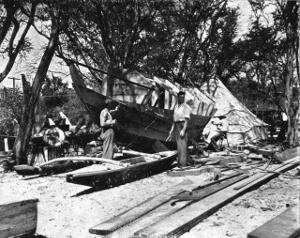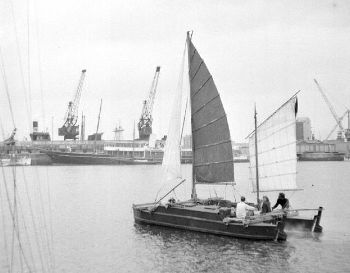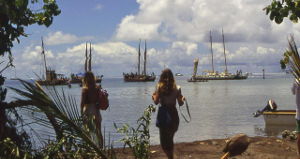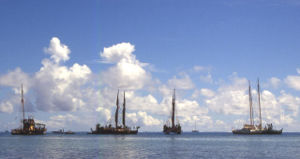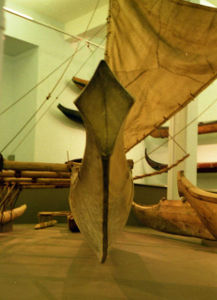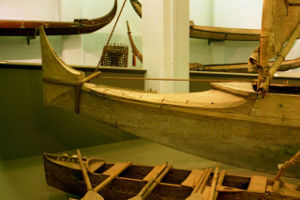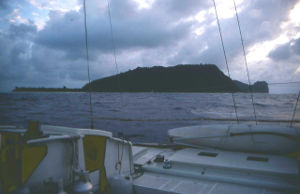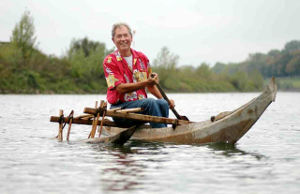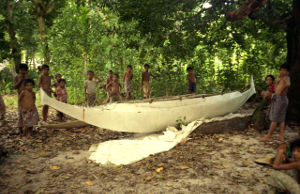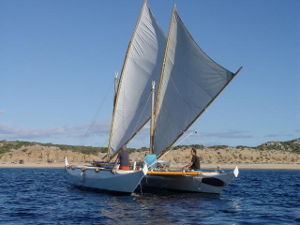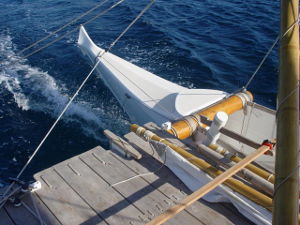The first of two papers, delivered by James Wharram at the 'Early Man and the Ocean' conference, held at Norwegian Maritime Museum & Kontiki Museum, Oslo.
In a few weeks I will be 80 years old. As a young man, dreaming of sea adventure, I was inspired by Thor Heyerdahl and his 1947 Kontiki voyage. We must never forget, with his Kontiki voyage, Heyerdahl revolutionised the approach to marine archaeology. With this voyage, he established the basic premises of Experimental Marine Archaeology, which continue to this day.
Heyerdahl had addressed himself to THIS problem: "How had Pacific Ocean Man arrived across 1000s of miles of ocean in the central Pacific islands?"

He had studied an abundance of data from South America, which led him to believe that the settlement of the central Pacific islands came from the South American Pacific coast.
Writing about this collected data, Heyerdahl could have had a secure academic life. What Heyerdahl did 60 years ago, was to risk his life and those of his friends to sail a small – the size of a medium sized modern yacht – historic Peruvian coastal Balsa raft across the Pacific.

He proved that such a simple craft was seaworthy in gales, that it could carry food and water for 6 men for several months. The lyrical passages in his best selling book 'The Kon-Tiki Voyage', showed that not all was hardship and suffering on this voyage, but a lot of the time there was a feeling of companionship, of beauty, of oneness with the ocean. This special feeling, voyaging on an ancient craft is an unstudied aspect of migration psychology.
As a young man, I was also inspired by a second hero, Eric de Bisschop, the Frenchman who in 1937 built a 38ft version of a Pacific double canoe in Hawaii and with a companion sailed it back across 3 oceans to France. His theory was that the ancient Pacific people sailed out of Asia into the Pacific on canoe craft. At that time the canoe craft of Asia and the Pacific were considered by academics as unseaworthy.
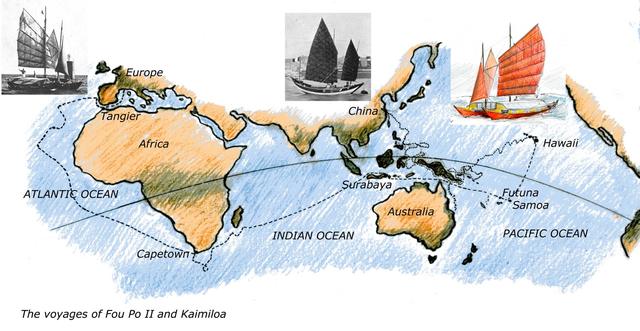
I agreed with de Bisschop's West – East theory and that the Polynesian double canoe was a seaworthy craft. I wished to emulate the spirit of the voyages of Heyerdahl and de Bisschop and to prove the seaworthiness of the double canoe.
To this end I studied in British museums and libraries, and found in the South Kensington Science Museum in London this model of a 21 ft Tahitian reef canoe. For shelter from cold northern seas I distorted the hull lines for comfort, so I could sit up in the hulls, and between 1954 and 1956, with the aid of 2 German girls built and sailed this double canoe, which I called Tangaroa, to Trinidad in the West Indies. This coastal/ocean voyage confirmed the sea survival abilities of a small double canoe/raft. See Two Girls, Two Catamarans.
My Atlantic voyage, plus various facts I had observed in my museum studies led me to believe that a major factor in giving the ancient Pacific voyaging canoes the ability to sail to windward, was a V-eed hull cross-section.
In Trinidad, in 1958, while living on a self-built Kon-Tiki inspired house raft, I built a 40ft V-eed hulled double canoe; on its first sail it sailed faster to windward than a modern 38ft ocean racing yacht. We, myself and the 2 German girls, then sailed the 40ft Rongo 1500 miles North to New York and 3500 miles across the North Atlantic to Britain, the first successful West-East crossing of the North Atlantic by multihull.

By the end of 1959 we had confirmed the storm-riding, seagoing and windward abilities of the double canoe of the Ancient Pacific.
In the next 6 years the canoe/raft ship emerged as a Western yachting type, under the names of catamaran and trimaran. My building and voyaging experience established me as a designer of such craft.
By 1976 I had sold several hundred double canoe/catamaran designs. I was able to display this chart at a London Boatshow, showing the worldwide voyages made by these craft. I had provided a version of the migration craft of the Stone Age Pacific for Western Urban Man, and interestingly, a marked number of them decided to make migratory voyages.
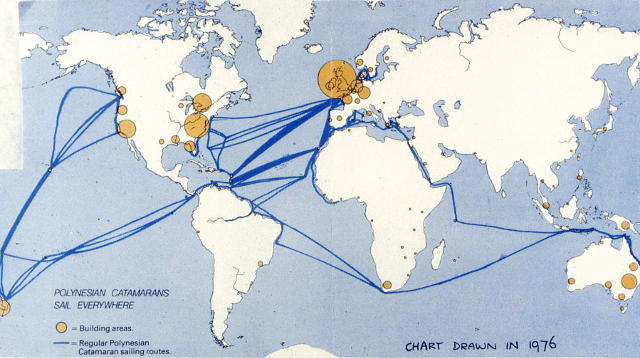
This natural desire to voyage could be an important factor in "Why did the settlement of the Pacific Ocean occur?" Not, as has been suggested by the Hawaiian school of Pacific studies, war, famine, the egos of great chiefs, leading to imposing fleets of large vessels searching for new islands.
What I am considering is that Man as a species has for the major part of his existence lived a migratory, nomadic life; that the first Pacific and Indian Ocean sailors were seagoing Nomads, living on the wealth of the sea and the seashore. Such groups still exist as in the nomadic Moken of the Andaman Sea, also known as 'Sea Gypsies'.
Three weeks ago, in Thailand, I met a German couple, who sailed on one of my 8m designs and had lived with the Moken. They had learned their language and had taken part in their ceremonies. They told me of the richness of such a sea-based life.
There were always doubters of my theory that some ancient Pacific canoe craft had V-eed cross section hulls so as to sail to windward, instead of leaving the dug-out hulls round and tree-shaped, as many believed. It is true that many later canoe craft do have round hulls, but these were designed to be paddled, not sailed!
In the early 1990s, in our further experimental studies, we built a 19m V-eed hull double canoe, 'Spirit of Gaia', and after hard testing her in the bay of Biscay and the wind acceleration zones of the Canaries, at the end of 1994 we sailed into the Pacific on an 8500 mile voyage to the island of Raiatea; to the 'Gathering of the Great Canoes' organised by the Hawaiian Polynesian Voyaging Society, to re-enact, so they said, a famous canoe gathering of the 13th century.
At this gathering there was a clashing of cultures, theories and ideas. However, Mau Piailug, the Micronesian Navigator did comment that he thought our Spirit of Gaia was a 'Real' canoe!
From Tahiti we sailed another 2700 Miles to Auckland, New Zealand. There in the Imperial Museum we found 'GOLD'.
In a small hall, the 'Canoe Room', we noticed a 9m outrigger canoe, labelled 'Tikopian Sacred canoe, presented to the museum in 1916'. The dugout canoe hull was sculpted exquisitely for windward ability, in a V shaped seagoing hull.
It had been in the museum for 80 years and NO-ONE had realised it answered the question, "did the Polynesians have hull shapes that could sail to windward?" This canoe proved THEY DID.
Later we found the distinctive Tikopian canoe hullshape had been recorded by Haddon and Hornell in their book 'Canoes of Oceania' in 1936 and before that by Admiral Paris after his visit to Tikopia in 1827.
Due to the remoteness of tiny Tikopia and the fact that Admiral Paris was one of the first European visitors, we believe the Tikopian hullshape has a very ancient heritage that has not been modified through European influence. Therefore a sailing replica of this hull shape can give information on the potential sailing abilities of a pre-Western-contact canoe type.
Also in Auckland, in the Maritime Museum library, we found another forgotten treasure, the rare 'Raft Book' by Harold Gatty. Written in 1943 for the US hydrographic office, for the help of wartime shipwrecked sailors and airmen.

This, as far as we know, is the first full practical study of the star, wave and cloud navigation methods of the Pacific sailors. A few years ago we sent a copy of this book to Lena Lisdotter Börjesson, who will be speaking later, perhaps she can confirm its value.
Continuing our Pacific voyage, we sailed into the Melanesian waters of the Pacific, the island groups of Vanuatu and the Solomons, inhabited by a race of people with facial features and skin colour that can be traced back across the Pacific to Australia and New Guinea.

On these islands land archaeologists have found a trail of sites with unique pottery remains, settlements of people referred to as the 'Lapita'. They are believed to mark the migration trail of the proto Polynesians out of Asia. The National Geographic Magazine has just published the latest theories on this in their March (2008) issue. Having met Melanesian people and studied their sailing craft, I have an open mind on who precisely these Lapita people were.
From Vanuatu we sailed to the small Polynesian outlier Tikopia, at the far Eastern end of the Solomon islands, to meet the chief whose great-grandfather had given the Sacred Tikopian Canoe to the Museum. They still use the same V-eed hullshape on their small canoes. The chief told me they still remember sailing bigger canoes to the Banks islands 150 miles away, a tough open ocean voyage.
In Tikopia we heard of a German yachtsman, Klaus Hympendahl, who when visiting Tikopia had entered into Tikopian life and was dedicated to helping to preserve their lifestyle. On return to Europe we contacted him.
From Melanesia we sailed on and out of the Pacific into the Indian Ocean, on to Sri Lanka. All the way meeting and studying raft stable canoe craft.
To sum up my observations of this voyage. By 2000 years ago half of the world's surface had been, or was being colonised by raft stable canoe form craft. Many different cultures united by a similar set of boat design principles. It is a subject for major future studies. A valuable introduction to such studies are the books 'Jukung Boats' and 'Building a Longboat', both published by the Vikingship Museum, Roskilde.
In 2003 Hanneke and I had a design commission from an American, Glenn Tieman, who 20 years previously had spent 10 years single-handedly roaming the Pacific on one of our 8 m designs. Now older, he wanted a larger, but simple, boat to repeat his youthful voyages.
We suggested that an 11m version of the Tikopian canoe hull shape, used as a double canoe, would give him sufficient physical comfort and load carrying capacity. We also told him we wanted to keep the craft totally Ethnic and rig her with Pacific Crabclaw sails. He immediately sent us $1000 to get on with the design.
Glenn has since built the design, which we called Tama Moana, Child of the Sea, and is now cruising her down the coast of Mexico. Klaus and Hanneke spent a week last November sailing with him to study the craft's unique sailing qualities. The photos you will see next were all taken during this sailing trial and show the beauty and seaworthiness of the design. I do not have time to make commentary now, but do talk to Hanneke or Klaus afterwards.
In January 2003 Tikopia and her tiny sister island Anuta were devastated by cyclone Zoe. Klaus Hympendahl was deeply involved with its after effects and raised funds to build a much-needed medical centre.
In January 2005, two years after Cyclone Zoe, my design partner Hanneke Boon was reading about the uniqueness of the self-sufficient culture of Tikopia in Jared Diamond's book 'Collapse'.
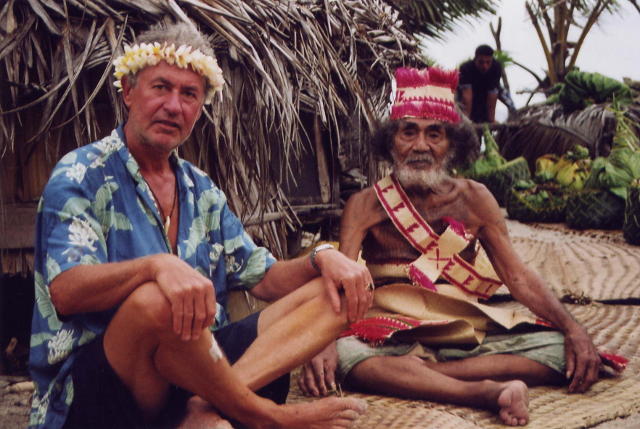
She had the 'vision' to build two Tama Moana double canoes for Tikopia and Anuta, to give the islanders back the independent ability to voyage to other islands, to visit their extended families, to trade, to take their sick to hospital. In fact take them back to the time, in the 1800s, when they had ocean-going canoes, with which they sailed 100s of miles to other island groups. This is how the Lapita Voyage project was born.
The Lapita Voyage project is to build two 11m Tama Moana double canoes. They will be built in the Philippines, at a yard experienced in building my double canoe designs. We will then sail the two canoes, one skippered by Hanneke and I, the other by Klaus Hympendahl, from there 3800Nm to the islands of Anuta and Tikopia, following the ancient migration route of the Lapita. South from the Philippines, the route will follow the North coast of Papua New Guinea and weave through the Solomon Islands. We will only be using traditional Pacific navigation methods. Most of this voyage will be island hopping, which in my experience is often harder and certainly slower then making ocean passages, but the final stretches of about 150 – 350 nautical miles will be across open ocean.
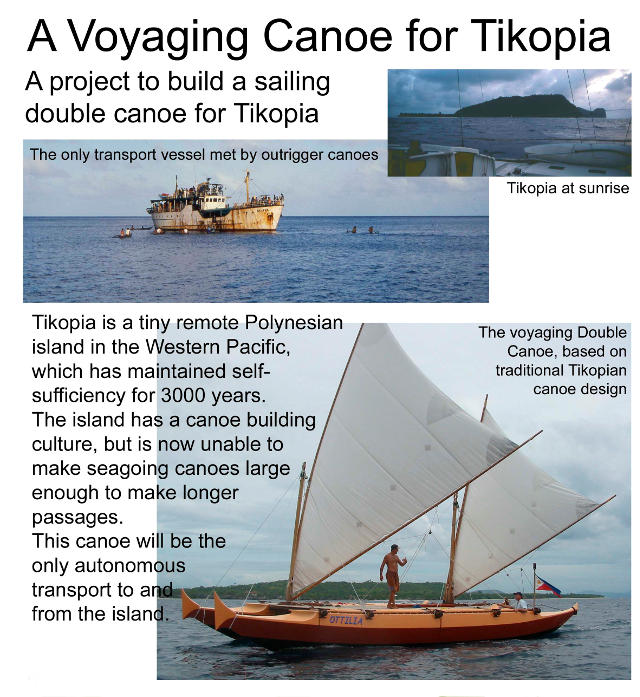
We will receive knowledge on Pacific navigation methods from a navigator from Tokelau, Tulano Toloa, who will be taking part in the expedition. He will also compare the fishing techniques of different islands, to find cultural connections.
What this voyage will give us, is what no academic studies can. We will be sailing the two boats like the original migration vessels, without engines or escort boat; we will be experiencing how voyaging on traditional double canoes will have felt to the 'Lapita' voyagers.
We will experience the climate, the sea and weather conditions, the geography of the islands and suitable landing sites. Hopefully we will also find some of the native food plants that still grow there and catch seafood and fish.
This will enable us to study the location of the archaeological Lapita sites from a migrating sailor's perspective, which could give insights no land archaeological studies can.

On each canoe will sail a man from the 'islands', one from Tikopia, one from Anuta. They will give insights into how an islander, who has lived his whole life on a tiny island, closely integrated with the ocean, will experience such a voyage, how he will fish for food, how he would cook it, what natural navigation instincts he has, how he 'feels' on such a voyage.
The building of two boats has started this month and the voyage is planned to start in November 2008, making use of the Westerly Monsoon winds.
As with all projects the biggest problem is finance. Klaus Hympendahl has been responsible for raising sponsorship for the Project over the last year. We have so far succeeded in being offered many of the materials for building the boats as well as a lot of the expensive equipment we will need.
The building of the boats and the voyage will be recorded on film, which will be made into a television program.
The voyage will end in Tikopia and Anuta where the boats will be presented to the islanders.
I hope in the future to report back on the results of this voyage, hope to see you then.
I began this lecture with a tribute to Thor Heyerdahl, I must end it with a thanks to Ole Crumlin Peterson, who with his staff at the Roskilde Vikingship Museum have been my inspiration for the last 27 years, guiding me towards critical assessment of facts, checked by experimental field work. Without their example I would not have been here today.

